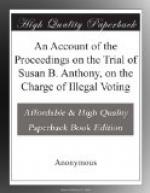Let us first of all see precisely what were the facts. Miss Anthony was charged with having knowingly voted, without lawful right to vote, at the Congressional election in the eighth ward of the City of Rochester, in the State of New York, in November, 1872. The Act of Congress under which the prosecution was brought provides that, “If, at any election for representative or delegate in the Congress of the United States, any person shall knowingly personate and vote, or attempt to vote, in the name of any other person, whether living, dead or fictitious, or vote more than once at the same election for any candidate for the same office, or vote at a place where he may not be lawfully entitled to vote, or vote without having a lawful right to vote, every such person shall be deemed guilty of a crime,” &c.
The trial took place at Canandaigua, in the State of New York, in the Circuit Court of the United States, before Judge Hunt, of the Supreme Court of the United States.
The defendant pleaded not guilty—thus putting the Government upon the proof of their entire case, admitting, however, that she was a woman, but admitting nothing more.
The only evidence that she voted at all, and that, if at all, she voted for a representative in Congress, offered on the part of the government, was, that she handed four bits of paper, folded in the form of ballots, to the inspectors, to be placed in the voting boxes. There was nothing on the outside of these papers to indicate what they were, and the contents were not known to the witnesses nor to the inspectors. There were six ballot boxes, and each elector had the right to cast six ballots.
This evidence would undoubtedly warrant the conclusion that Miss Anthony voted for a Congressional representative, the fact probably appearing, although the papers before the writer do not show it, that one of the supposed ballots was placed by her direction in the box for votes for Members of Congress. The facts are thus minutely stated, not at all for the purpose of questioning their sufficiency, but to show how entirely it was a question of fact, and therefore a question for the jury.
Upon this evidence Judge Hunt directed the clerk to enter up a verdict of guilty. The counsel for the defendant interposed, but without effect, the judge closing the discussion by saying, “Take the verdict, Mr. Clerk.” The clerk then said, “Gentlemen of the jury, hearken to your verdict, as the Court has recorded it. You say you find the defendant guilty of the offence whereof she stands indicted, and so say you all.” To this the jury made no response, and were immediately after dismissed.




